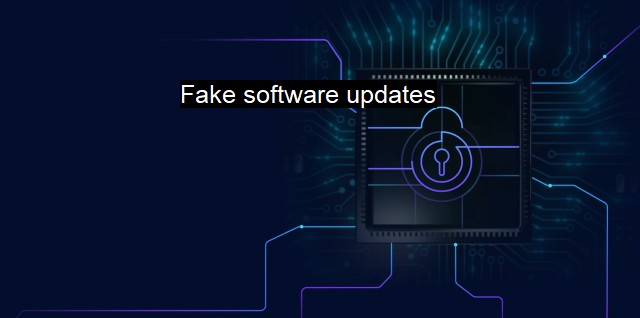What are Fake software updates?
Beware of Fake Software Updates: The Threats of Malware and Cybercrime to Your Digital Devices
Fake software updates, which also go by the name "rogue software updates,” pose a huge cybersecurity threat, contributing significantly to fraudulent activities and cybercrimes worldwide. The Federal Bureau of Investigation (FBI) has seen an increase in such fraudulent schemes involving fake software updates, which primarily breach cybersecurity systems to invade and infect the users' computers.Simply put, fake software updates are deceptive alerts or pop-ups that mimic the appearance of a legitimate software update, but are, in reality, malicious tools. They typically display an intimidating wake-up alarm suggesting that the user's computer is outdated by several software versions. Unwary users, swayed by these fraudulent alerts and an apparent urgency to keeping their systems up-to-date, oblige these prompts - leading to disastrous consequences.
Unlike traditional viruses or Trojan attacks that restrict their damage to corrupting files or disabling systems, rogue software updates are more sophisticated. Once successfully downloaded and installed, they perform intrusive acts such as stealing the user's personal and financial information, demand ransom, disrupt operations or infect other systems in the network with malicious software.
Understandably, phishing users through fake software updates is a favourable strategy for cybercriminals. Firstly, due to the apparent necessity and frequency of updates, many people have cultivated the reflex to click ‘update’ instantly when a software update notification pops up without second thought. Secondly, the activities of these rogue updates can fly under the radar of many antivirus programs, making them difficult to detect and remove.
For instance, in the infamous Mac Auto Fixer malware episode, users were harassed with advertisements demanding that they download the ‘latest’ antivirus version to fight viruses that actually did not exist on the infected Mac computer. The malware succeeded in bypassing the inbuilt Apple security mechanisms, causing major confusion and panic among affected users.
Cybersecurity experts recommend several proactive measures against fake software updates. Primarily, vigilant behaviour or a good measure of suspicion is suggested. Users need to carefully analyse the alert message, check the source website's URL for legitimacy, or cross-verify if an update is indeed due with the software’s official page. Pop-ups that suddenly appear out of the blue on a browser, suggesting updates, should be treated with skepticism.
Secondly, a reputable and robust antivirus software can significantly reduce the risk of falling prey to rogue software updates. Systematic regular scans, intuitive firewall protection, routine software updates and including real-time security from trustworthy internet security providers can invariably shield users' computers from such attacks. enabling automatic updates for software can counter fake software update scams by ensuring the latest versions are always in use.
Another crucial practice is to refrain from downloading software or updates from peer-to-peer networks or free-software sites. These platforms are notorious for harbouring malware in downloadable files, primarily in the form of rogue software updates.
Fake software updates are a cunning method through which cybercriminals exploit the user's instinct to keep their system updated. As such, educating users about the authenticity and source verification of software updates is instrumental in maintaining cybersecurity. Cyber-awareness, together with a robust protective setup, can significantly reduce the fraudulent manipulations of cybercriminals and safeguard the integrities of personal and business operating systems.

Fake software updates FAQs
What are fake software updates and how can I identify them?
Fake software updates are malicious programs that masquerade as legitimate software updates, but are designed to infect your system with malware or steal your personal information. To identify fake updates, always verify the source of the update and look out for spelling and grammar errors in the notification.How do fake software updates get onto my computer?
Fake software updates can be delivered through spam emails, malicious websites, or social engineering tactics. They may also be bundled with legitimate software downloads or come as a pop-up notification when surfing the web.What are the risks of installing fake software updates?
The risks of installing fake software updates include malware infections, data theft, and financial loss due to identity theft. Some fake updates may also contain ransomware that can lock you out of your computer and demand payment for access.How can I protect my computer from fake software updates?
To protect your computer from fake software updates, always download updates from reputable sources and keep your antivirus software up-to-date. Be wary of unsolicited emails or pop-up notifications and never click on links or download attachments from unknown senders. Additionally, use a virtual private network (VPN) to encrypt your online activity and protect your sensitive data from cybercriminals.| | A | | | B | | | C | | | D | | | E | | | F | | | G | | | H | | | I | | | J | | | K | | | L | | | M | |
| | N | | | O | | | P | | | Q | | | R | | | S | | | T | | | U | | | V | | | W | | | X | | | Y | | | Z | |
| | 1 | | | 2 | | | 3 | | | 4 | | | 7 | | | 8 | | |||||||